At the end of our trip to South Melville yesterday, Trudy, whose Chevy Bolt I’d driven there and back, called up the “Range Impacts Since Last Full Charge” screen, which shows factors that influenced the range of the car:
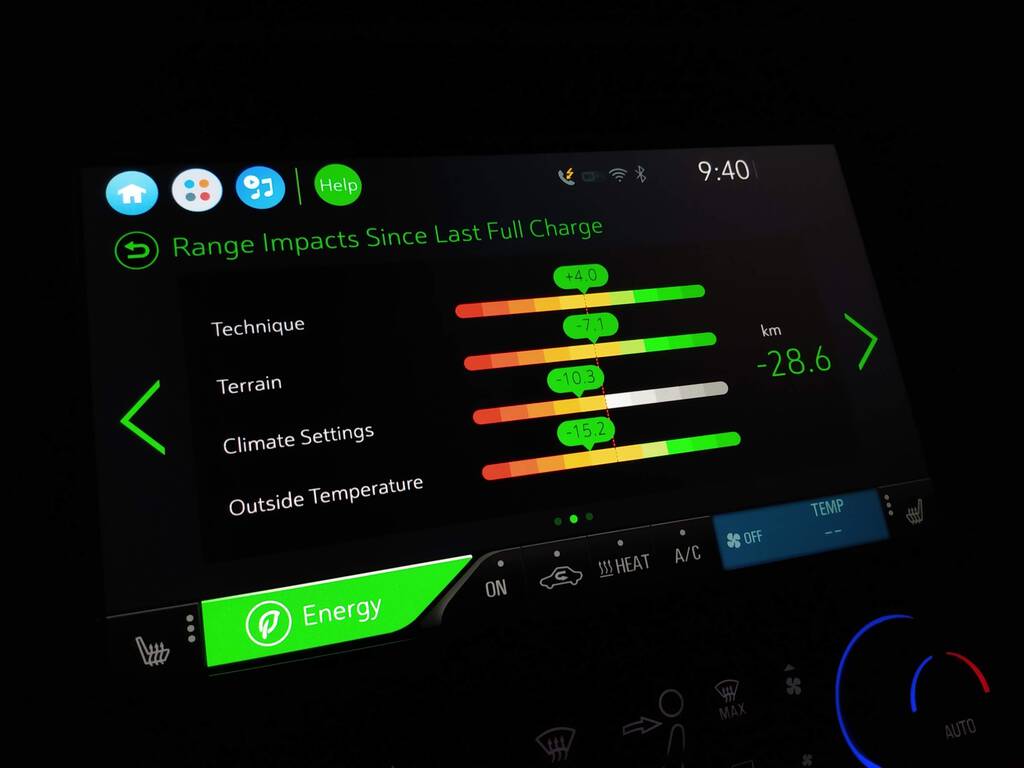
The outside temperature last night was about 4ºC, which explains the 15 km loss there; it also explains why we lost 10 km from “climate settings,” as we needed to turn on the defroster a couple of times.
The 7 km loss from “elevation” can be explained by the hilly terrain between Charlottetown and South Melville:
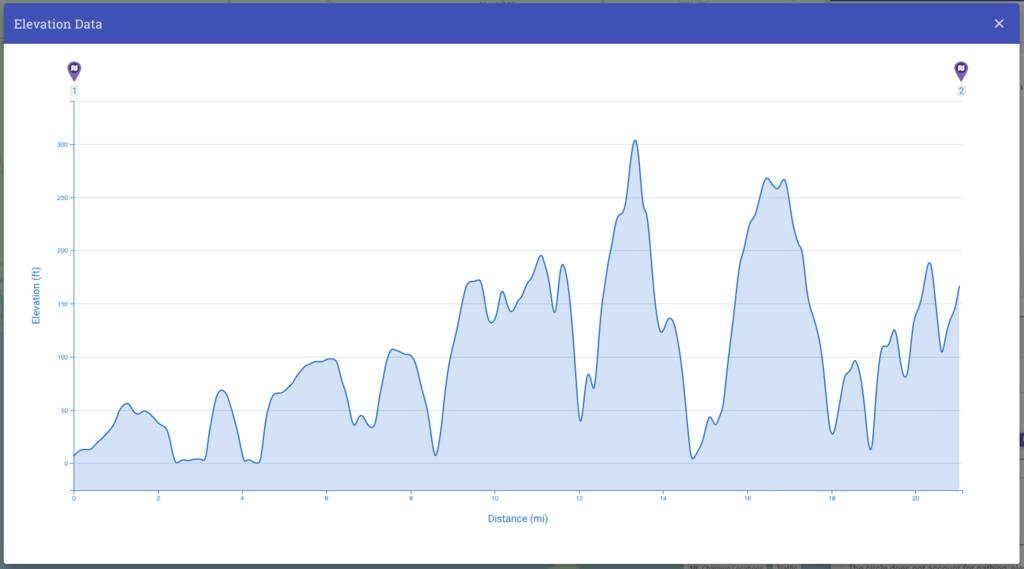
The elevation between Charlottetown and South Melville, from PlugShare.com
The most interesting number–and the only one that I had any influence on–is “technique,” and it reflects my behaviour braking and accelerating. And my (essentially random) technique scored us an additional 4 km of range.
Earlier this morning Terry Howatt thoughtfully left a comment here about a meeting tonight of the PEI Electric Vehicle Association in South Melville.
As I’m curious about such things, and eager to learn more from people who aren’t try to sell me something, I dropped a line to my new friend Trudy (who also came to me by way of this blog) to see if she wanted to go to the meeting with me. Trudy is almost two months into her own experience as an electric vehicle owner: she purchased a Chevy Bolt at the end of May.
Trudy quickly wrote back, said she was game, and offered me a drive. When she showed up at my place at 5:45, she hopped out of the driver’s seat and offered me the opportunity to drive the Bolt, which I eagerly accepted.
When we arrived at Harry Smith’s house in South Melville we were greeted by three Nissan Leafs, a Tesla Model S, a Tesla Model 3, a homebrew SUV conversion, and another Bolt. And an enthusiastic group of EV owners and owners-to-be.
The proceedings were informal, the refreshments were well-turned-out, and the group proved generous and willing to answer my endless stream of questions.
Driving Trudy’s Bolt was a joy: it’s fun to drive, comfortable and roomy; after 20 minutes I forgot that I was driving an electric car.
If you’re interested in attending the next monthly meeting, or if you simply have questions about electric vehicles, you can contact the group by email at peieva2019@gmail.com.
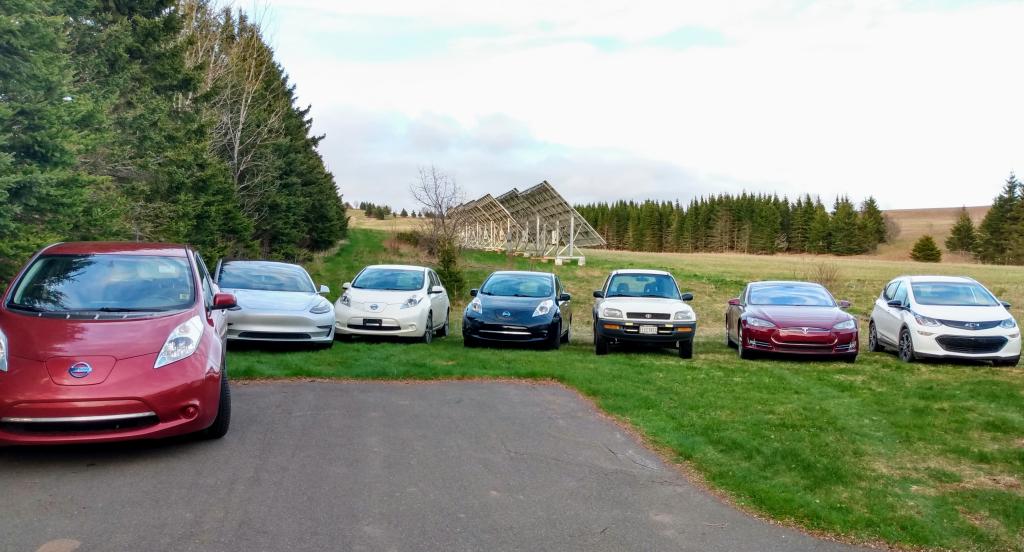
Archdeacon John Clarke, Rector of St. Paul’s Anglican Church, in a blog post today:
That’s why it is important for the Church (our Church) to remain cautious about how we behave in the world, by what we buy, believe, support and protest. That’s why it is important for us to continue to do things like participating in the Pride Parade, either as participants or spectators, to show our support of several groups of people who are persecuted, in one way or another for no good reason.
It’s a little disconcerting, I must say, to see the crowds lining the streets of Charlottetown do a double-take when they see St. Paul’s Church in the Pride Parade. It is sad that only two churches participate in the Parade, because as along as people are persecuted, imprisoned and even sentenced to death due to their sexuality we have a responsibility to stand with, march with and celebrate with them until they enjoy freedom. The price of a guilty conscience is too much.
Pride PEI marks 25 years on PEI and this years Festival begins on July 20, and the Pride Parade is scheduled for July 27. The price of not being supportive is too much.
I’m proud to be the Church’s neighbour.
One of the more intriguing aircraft in the extended Air Canada family fleet is the Beechcraft 1900, operated by EVAS as Air Canada Express, and used on the short Charlottetown to Halifax run.
It is an almost universal experience of flying on one of these planes that a conversation strikes up among passengers, marveling at how Lilliputian they are. The planes have 18 seats, one on either side of the aisle, and although they’re small, they’re also tall, and thus surprisingly roomy.
In December 2015, Oliver and Ethan the Dog and I flew to Montreal via Halifax, and it was our first experience taking Ethan on the Beechcraft. Standard operating procedure for Ethan on airplanes is that he sits under the seat in front of Oliver; while that might have worked–it would have been tight, but he can curl up like a pretty tight ball of dog–the first officer, in making his rounds up and down the aisle (in lieu of a flight attendant), told us that Ethan was welcome to sit on the empty seat in front of Oliver.
And so he did.
He was wearing his car harness, and we tethered that to the airplane seatbelt, and he was perfectly content to keep an eye on Oliver from that perspective.

The newly-elected Green Official Opposition in Prince Edward Island is hiring three positions, with a closing date of May 22, 2019:
Here’s an comparison of the maps of Crapaud in Google Maps and OpenStreetMap.
OpenStreetMap

Google Maps

Here’s a a more detailed view of the centre of Crapaud:
OpenStreetMap

Google Maps

How I Made This
In QGIS I created a new map, and then, under Layer > Data Source Manager > Browser, I added the OpenStreetMap layer and the Google Maps layer:
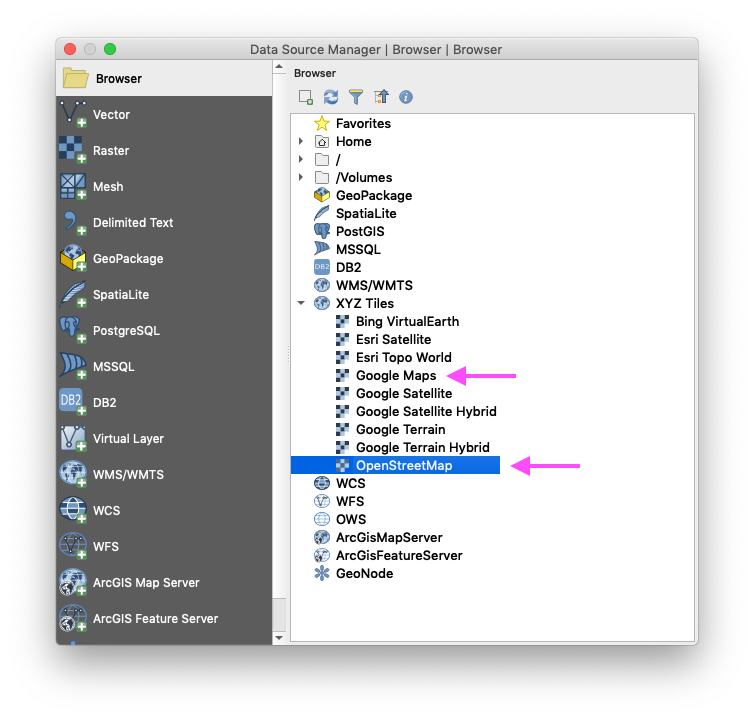
Toggling one off and one on, and the switeching, I made equal-sized screen shots of Crapaud and saved them as PNG files.
In the April 2019 Prince Edward Island general election both the Green Party and PC Party platforms promised to incentivize electric vehicle purchases (“Create a purchase incentive for electric vehicles” and “Develop a solar energy rebate and electric vehicle incentive program,” said the platforms, respectively); added to the recently announced federal inventive program, there might never be a better time to purchase a new electric vehicle on PEI.
If you can find a dealer to sell you one, that is.
The federal program covers vehicles from 14 manufacturers, but only Chevrolet, Ford, Hyundai, Kia, Nissan and Volkswagen have dealers in Charlottetown that sell battery-electric vehicles (as opposed to hybrids), and of those 6 makes:
- Hillside Chevrolet has one Bolt on the lot, but it was sold and can’t be taken for a test drive (they’re expecting another soon).
- Fair Isle Ford doesn’t carry the Focus Electric.
- Experience Hyundai doesn’t carry any electric vehicles.
- Discover Kia doesn’t carry any electric vehicles.
- Centennial Nissan carries the Nissan Leaf, but doesn’t have any on the lot (they’re expecting two in the next couple of weeks).
- Brown’s Volkswagen doesn’t carry the e-Golf (they told me there are none sold east of Ontario).
In other words, although the federal government will rebate me $5000 for the purchase of a battery-electric vehicle, there’s not a single battery electric vehicle in Charlottetown that I can take for a test drive.
Transport Canada has a helpful page of resources on electric vehicles that includes a link to a map of charging stations.
The map includes a link to a developer API at the US National Renewable Energy Laboratory; by signing up for a free API key you can get the information from the map as JSON or XML.
With the API key, this request will return all the charging stations on Prince Edward Island:
https://developer.nrel.gov/api/alt-fuel-stations/v1.json?fuel_type=ELEC&state=PE&country=CA&format=JSON&api_key=[API KEY GOES HERE]
The API returns JSON. If I want to convert that to GeoJSON, I can use JavaScript:
var getJSON = require('get-json')
var GeoJSON = require('geojson');
getJSON('https://developer.nrel.gov/api/alt-fuel-stations/v1.json?fuel_type=ELEC&state=PE&country=CA&format=JSON&api_key=[API KEY GOES HERE]', function(error, response){
var stations = GeoJSON.parse(response.fuel_stations, { Point: ['latitude', 'longitude'] });
console.log(JSON.stringify(stations));
});
The API returns 25 charging stations from Prince Edward Island (as of May 13, 2019); normalizing the data, there are 21 unique locations.
Visualizing them on a map, it becomes clear that they are concentrated in Summerside and Charlottetown, with none west of Cape Egmont nor east of Montague (it seems like an unrealized public relations and tourism opportunity to not have partially wind-powered EV station at North Cape and Hermanville).
By Geography
- Charlottetown Area (6)
- Capital Honda
- Clarke Nissan
- Delta Prince Edward Hotel
- Inn On The Harbour
- Charlottetown Mitsubishi
- Town of Stratford
- Summerside (9)
- Causeway Bay Hotel
- Credit Union Place
- Holland College
- Kool Breeze Farms Garden Centre
- Slemon Park Hotel
- Summerside City Hall
- Summerside Electric Light Plant
- The Quality Inn
- Township Chevrolet Buick GMC
- Other (6)
- The Bottle Houses (Cape Egmont)
- Island Stone Pub (Kensington)
- Rossignol Winery (Little Sands)
- Lanes Riverhouse Inn and Cottages (Montague)
- Prince Edward Island Preserve Co. (New Glasgow)
- Around The Sea Rotating Suites & Tours (North Rustico)
By Host
- Municipal (4)
- Town of Stratford
- Credit Union Place
- Summerside City Hall
- Summerside Electric Light Plant
- Car Dealership (4)
- Capital Honda
- Clarke Nissan
- Charlottetown Mitsubishi
- Township Chevrolet Buick GMC
- Lodging (7)
- Delta Prince Edward Hotel
- Inn On The Harbour
- Causeway Bay Hotel
- Slemon Park Hotel
- The Quality Inn
- Lanes Riverhouse Inn and Cottages
- Around The Sea Rotating Suites & Tours
- Other (6)
- Holland College
- Kool Breeze Farms
- The Bottle Houses
- Island Stone Pub
- Rossignol Winery
- Prince Edward Island Preserve Co.
I’m posting this both to get a May 2019 baseline that we can compare to as EV charging becomes more widespread, and with hope that others will use the open data that Transport Canada is helpfully providing.
CBC Prince Edward Island is running a story today, Slowdown in P.E.I.’s IT sector growth concerns former head of industry association, that is illustrated with a photo of a person holding an older iPhone standing on a subway that looks an awful lot like it’s in Toronto:

The photo choice struck me as odd, and I suspected that this was another example of the use of generic stock photography.
Sure enough, this photo is very popular, both with the CBC and with members of the Canadian Press (the source of the photo) like The Globe and Mail:
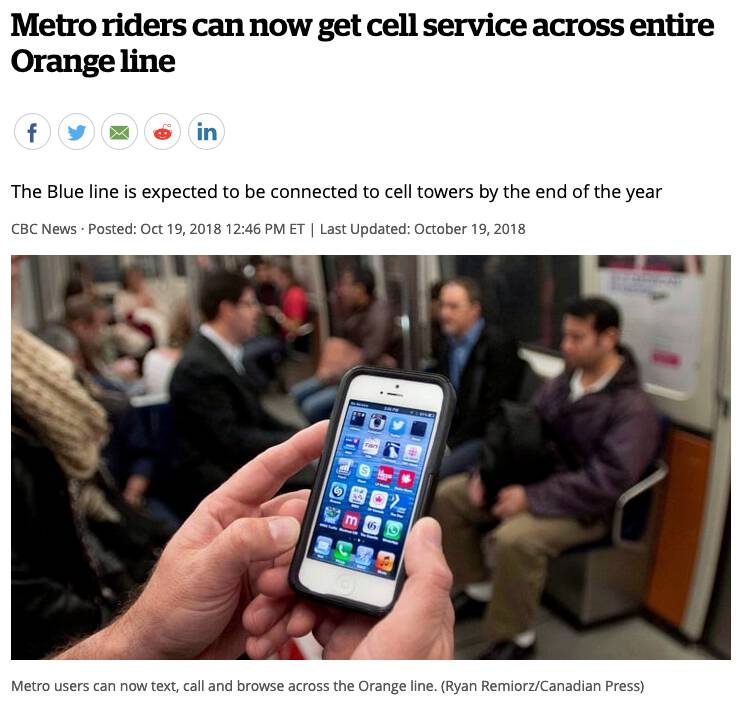
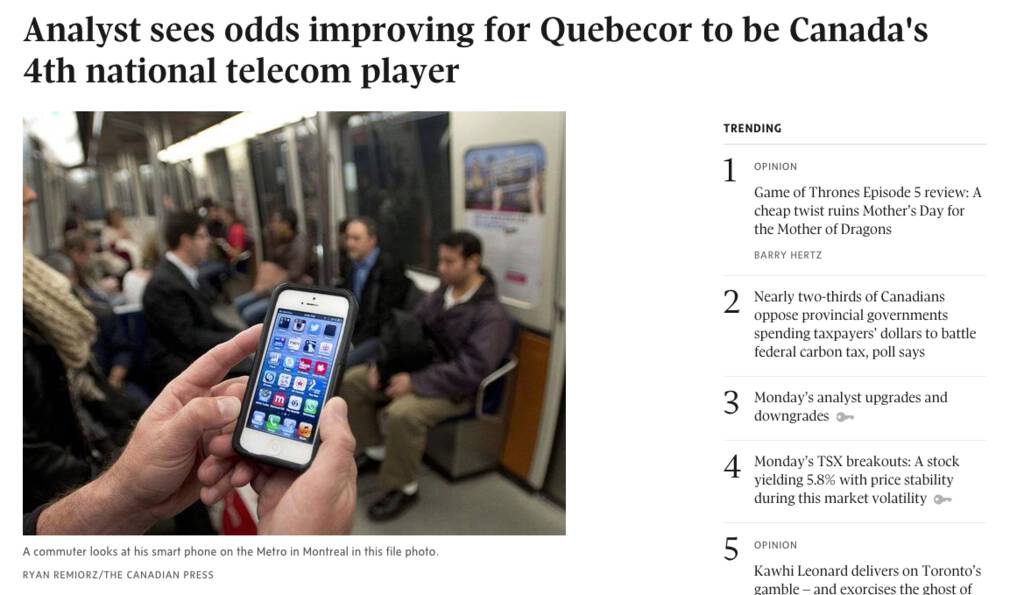
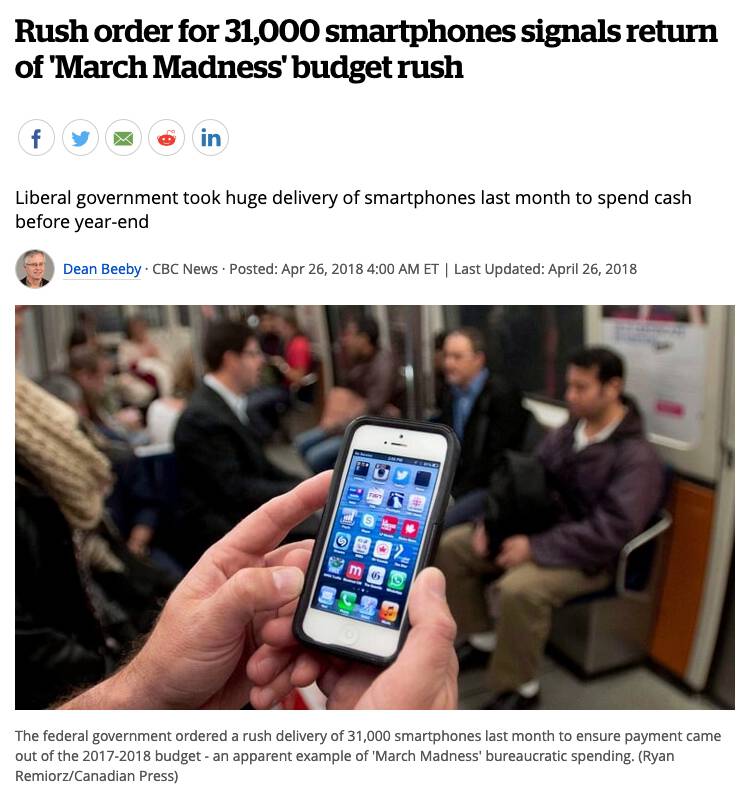
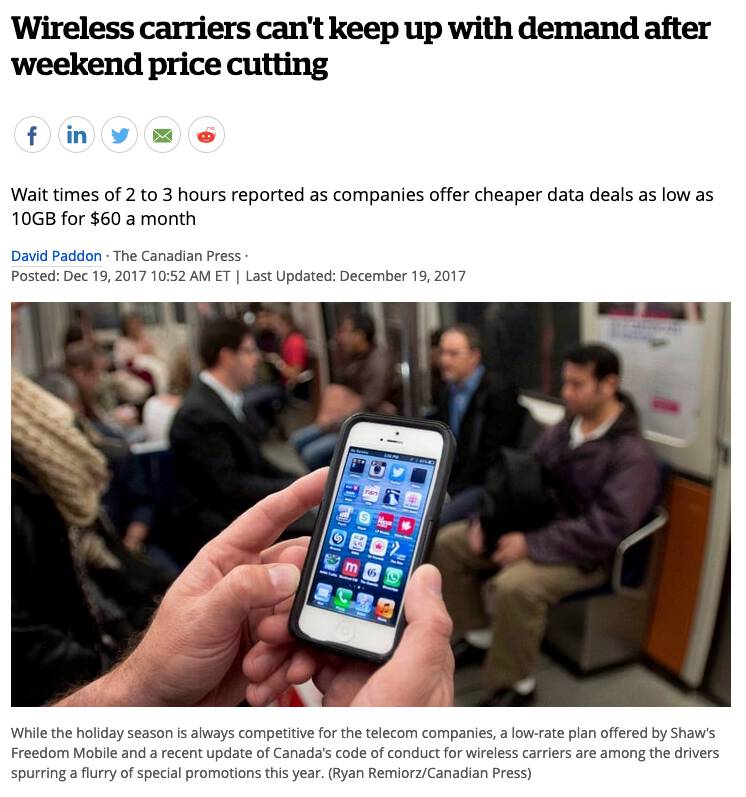

While it’s convenient to attribute this lazy use of generic stock photos to journalists who search stock photo libraries for “technology,” the real culprit here is content management systems that require a photo, regardless of its journalistic value.
And the culprit behind that requirement is the way that search engines display stories with photos more prominently:

The underlying culprit is that success in journalism is increasingly measured in clicks, not craft.
Last week I read an interview with Musician Tashi Wada in The Creative Independent. The interviewer, Grayson Haver Currin, asked Wada about his parents:
At what point did you realize that everyone else’s parents weren’t artists, or that something was different with your family?
We lived in one of these Fluxus co-op buildings, so it was a lot of Fluxus artists. Simone Forti was our nextdoor neighbor. Nam June Paik lived upstairs. At school, since it was New York, it was a pretty eclectic mix of people. But the specific memory I have was we were asked to go around the class and say what our parents did. My dad did all kinds of plumbing in these buildings in SoHo, but I kind of knew that wasn’t really what he did. It was a side of his life, but it was not how he identified as a person. I didn’t really have a good answer in class. I remember going home and asking my mom, “What does Dad do?” She said, “Well, just say he’s self-employed.” Somehow that made sense. It makes sense to me now, as an adult—I’ve chosen a life that is determining it day-to-day, month-to-month. It feels self-directed.
I’d never heard of “Fluxus co-op buildings” nor of “Fluxus artists” and this led me down a fascinating rabbit hole; what emerged was a portrait of a movement that I could get behind:
Fluxus had no single unifying style. Artists used a range of media and processes adopting a ‘do-it-yourself’ attitude to creative activity, often staging random performances and using whatever materials were at hand to make art. Seeing themselves as an alternative to academic art and music, Fluxus was a democratic form of creativity open to anyone. Collaborations were encouraged between artists and across artforms, and also with the audience or spectator. It valued simplicity and anti-commercialism, with chance and accident playing a big part in the creation of works, and humour also being an important element.
The rabbit hole exited at Robert Filliou and La Cédille qui Sourit, a shop in Villefranche-sur-mer, France, that art historian Natilee Harren introduces, in La cedille qui ne finit pas: Robert Filliou, George Brecht, and Fluxus in Villefranche:
In the summer of 1965, Fluxus artists George Brecht and Robert Filliou opened a back‐alley shop in the French Riviera town of Villefranche‐sur‐Mer called La Cédille Qui Sourit, or “The cedilla that smiles.” The Cédille sold unique objects produced there by the artists as well as books and editions from Fluxus, MAT Editions, Something Else Press, and others. Yet this “non‐shop” (as Filliou called it), which looked more like an atelier than a store, was never commercially registered, and opened only by appointment. The experiment failed within three years. This essay sees the Cédille as a momentary flowering of the model of Fluxus’s “artworks‐in‐flux” into an alternative, anti‐instrumental, artist‐run economy of production, distribution, and exchange, developed in response to the expanding capitalization and exploitation of art and artists in the 1960s. Aspects of the Cédille discussed in this context include ephemera, writings, and objects such as the suspense poems, the “Non‐School” of Villefranche, the café‐genius, the gifting project, and the cedilla grapheme itself. Finally, Brecht and Filliou’s activities at the Cédille are considered alongside Hannah Arendt’s writings on labor, work, and action, especially in regard to the latter’s relationship to politics, art, and culture.
Also something I could get behind.
The works associated with Filliou, Brecht, and La Cédille qui Sourit are compelling.
This poster, from MOMA’s collection, for example, starts “there is always someone who makes a fortune, someone who is bankrupt (us in particular)”:
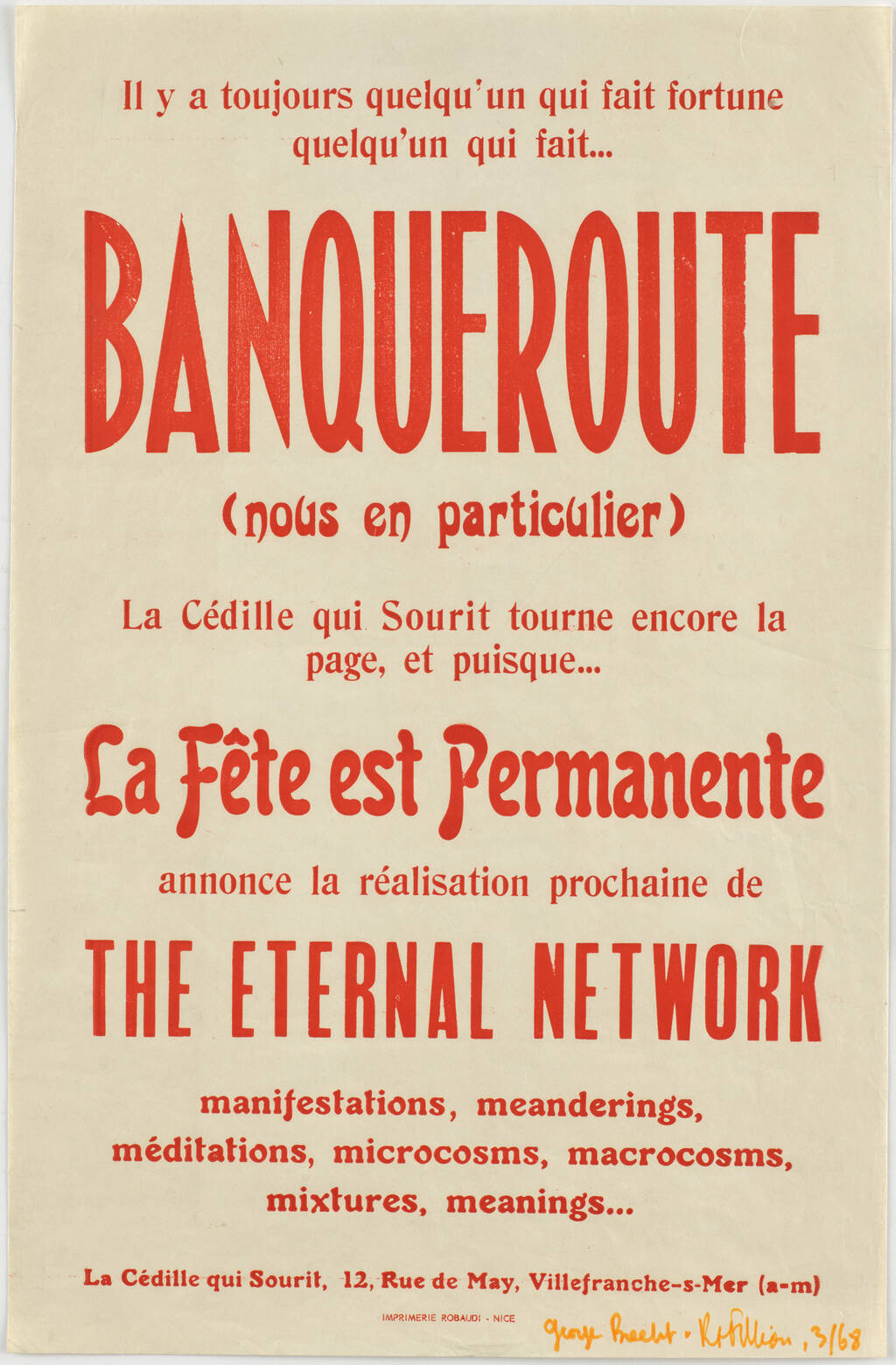
Or A New Way to Give People Headaches, also from MOMA’s collection:

My favourite work, however, is the La Cédille qui sourit, produced for a 1969 exhibition of the same name at Städtisches Museum, Mönchengladbach:
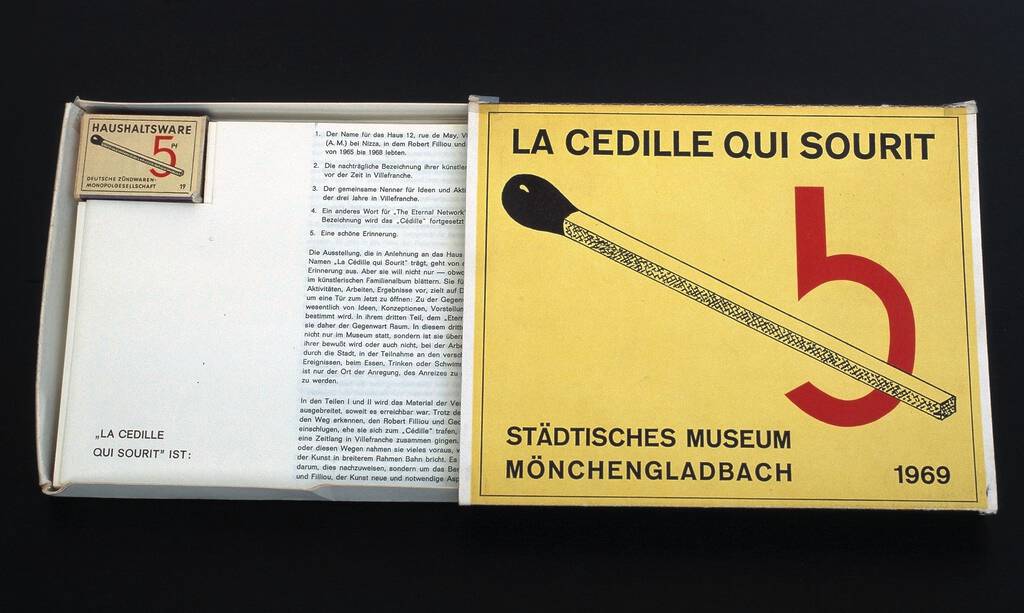
From notes about the piece in the M HKA Ensembles collection:
The choice of the dimensions of this box was part of the Städtisches Museum catalogue editing policy and the idea of the matchbox extra large came from the director of the museum Johannes Cladders. The box contains a text by Johannes Cladders, a list of works by Filliou and Brecht from before their collaboration, a list of their works made during their stay in Villefranche and the workingspot ‘La Cédille qui sourit’ (1965-1968) and some iconogeaphic cards with the headmark of ‘La Cédille qui sourit’ and some invitations to participate in the making of an anthology of jokes by returning postcards.
This is a piece that demands an homage, and so I set out to create one this weekend. This is what resulted:
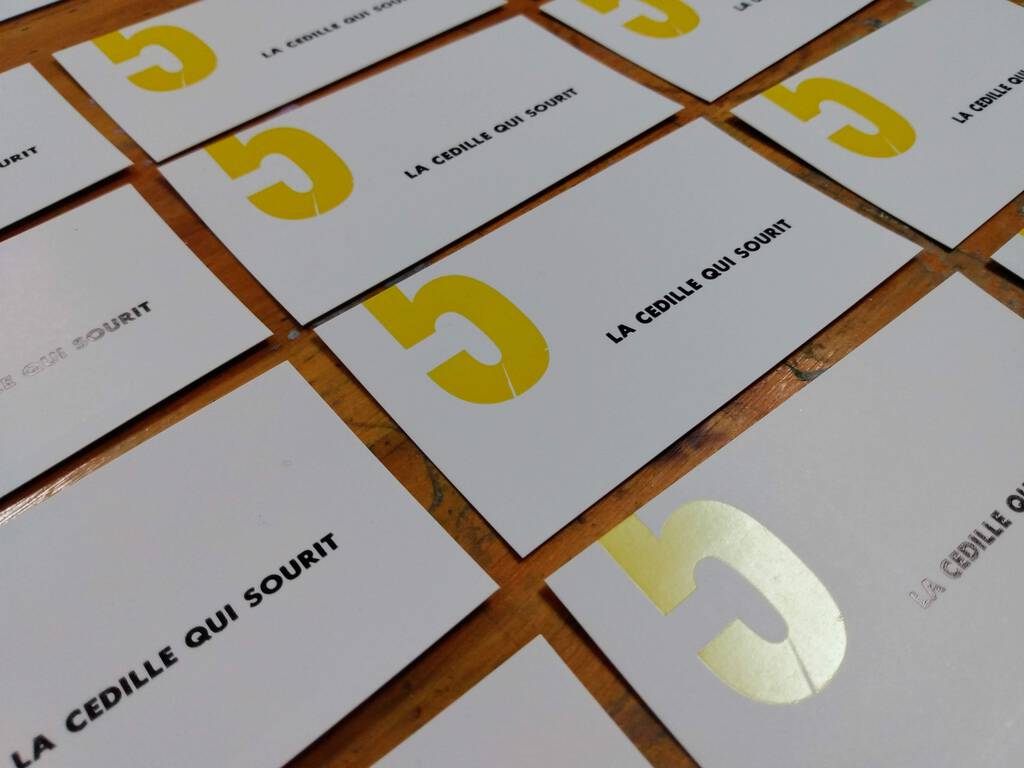
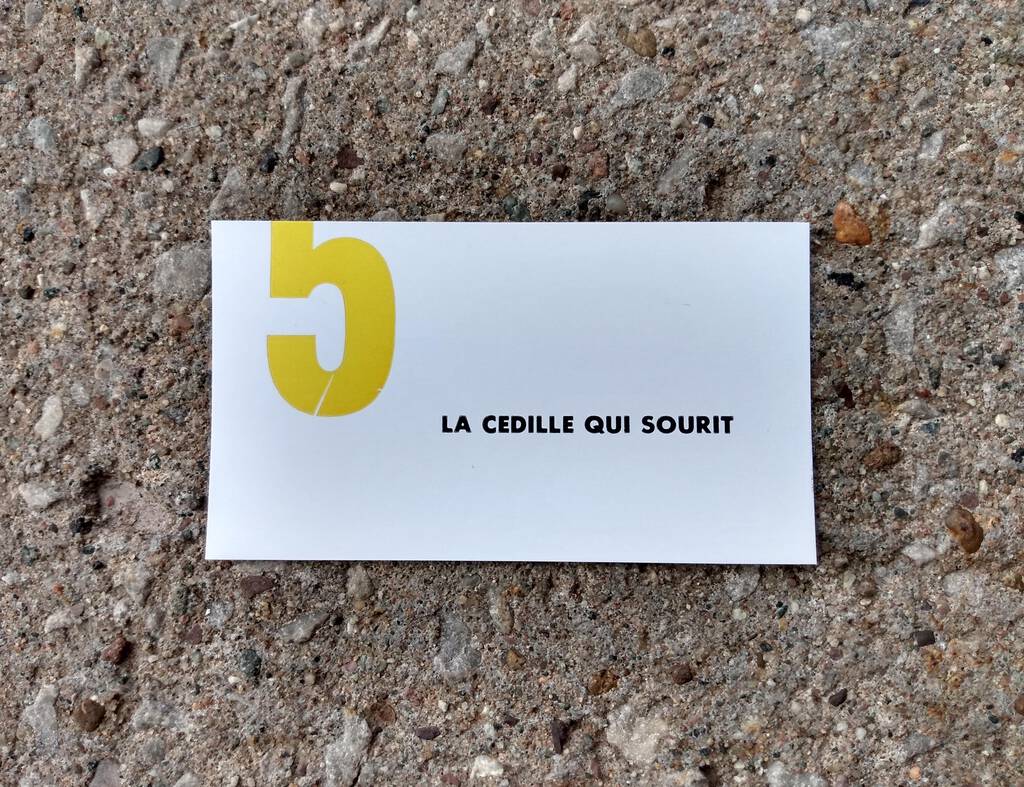
I printed fifty 90 mm by 55 mm cards on white coated cardstock (from the Bill & Gertie Campbell collection). The cédille itself is a hack–a beheaded “5” in 120 point Akzidenz Grotesk, printed in yellow ink from Southern Ink in Austin, TX. The text is printed in Southern Ink “dense black” in the 10 point sans serif face I picked up at the Museum of Printing last month.
If you would like one, PayPal me postage ($2 CAD for Canada, $2 USD for USA, €2 for international) and I’ll pop one in the mail to you.
 I am
I am